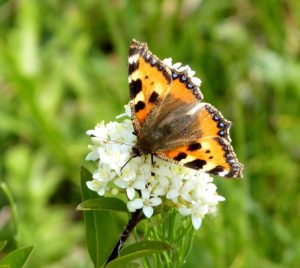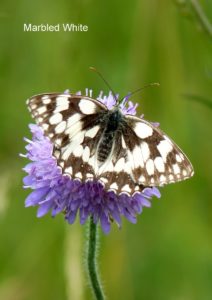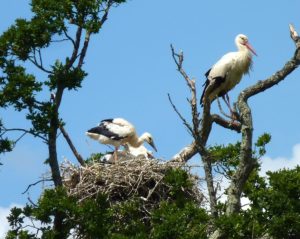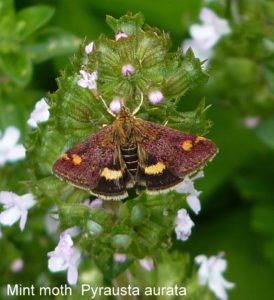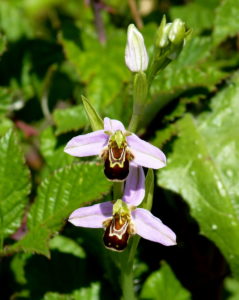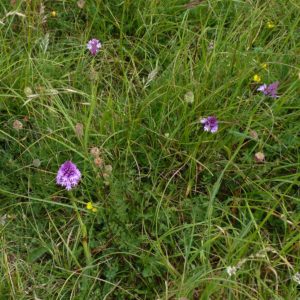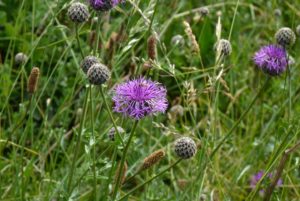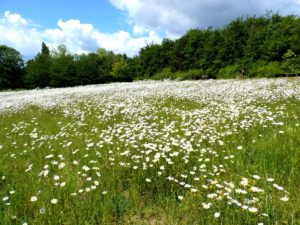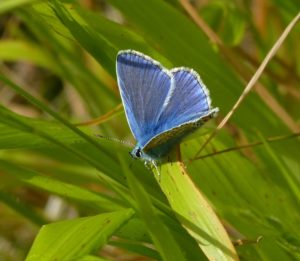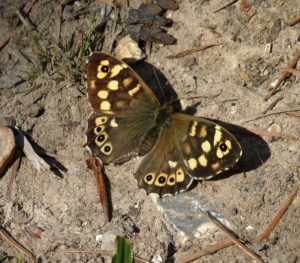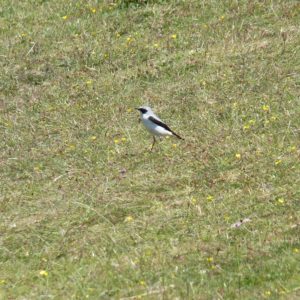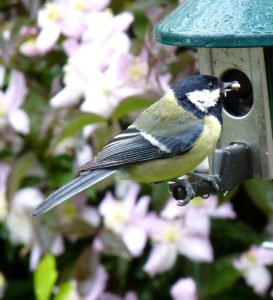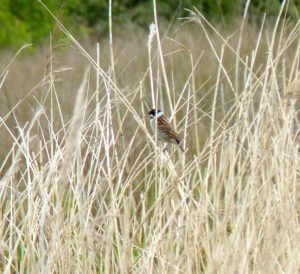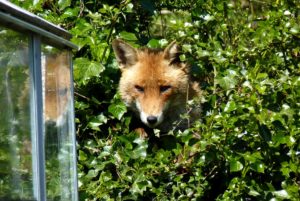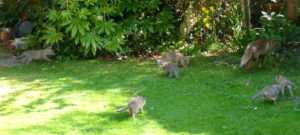Nature Notes – 16th June
A few Small Tortoiseshell butterflies have been seen on the Rife. Once exceedingly common, they are now only seen in very small numbers. Their eggs are laid on nettles and there are plenty of these on the Rife so it is unclear why they are in steep decline. If you see any in your garden please report them to me to my email address: pat@pathallpics.co.uk. If you walk up onto Highdown, the Marbled Whites have just emerged. Look out also for the Large and Small Skippers.
If you have an opportunity to travel up to the Knepp Estate on the A24 (only 20 minutes by car from Ferring) you will just catch the young storks before they leave their nest. This is the first time ever for 400 years that storks have bred in this country and right on our doorstep. A unique and wonderful experience which you may have seen on Springwatch.
If you are confined to your garden, look out for all the small ‘bugs’ that are visiting our plants. If you have a herb bed, you may see the delightful little Mint Moth. You could make a list of all the insects that you see in your garden: Ladybirds, Greenflies, Dragonflies, Damselflies, Bees, Wasps, Flies, Hover flies and Beetles.
Nature Notes – 5th June
Yesterday, a Spoonbill was spotted by Ron and Jan Tutheridge flying over Goring Gap.
A Cuckoo was also seen and many people have reported hearing a Cuckoo in the second half of May, especially over the Rife and further west. Yesterday, also, Clive Hope saw 4 Bottlenose Dolphins following a trawler off Ferring beach and David Campbell saw 6. So keep looking! Peter Dale has reported a few Bee Orchids in the North Lagoon together with Early Marsh Orchids. In the ‘Yurt’ field up McIntyre’s Lane Graham Tuppen has found 18 Bee Orchids.
On the reservoir there are small numbers of Pyramidal Orchids amongst the dry grasses, back after being mown to death for several years. It is very dry on the reservoir but I don’t think it has been mown. Highdown Hill is looking very dry but there are lots of Skylarks and a few Yellowhammers. Although the vegetation is parched, there are extraordinary numbers of Yellow Rattle flowers and the purple Lesser Knapweeds (Hardheads) are coming into flower.
The meadow below Highdown Gardens is covered in an astonishing number of Ox-eye Daisies. There are also many Common Broomrapes, a curious parasitic plant that produces no chlorophyll. It has pale yellow/fawn flowers and stems and no leaves.
The only butterflies of note are many Small Heaths on Highdown and some bright-blue newly-emerged Common Blues. In woodland, Speckled Woods are flitting about. At Patching there are Grizzled Skippers and Dingy Skippers and a few bright red and black Cinnabar Moths.
Finally, on June 1st on Cissbury, I saw a male Northern Wheatear, a very striking black and white bird. This is a very late record for a bird that may be making its way back to Greenland to breed.
Salsify on Sea Lane – Monday 11th May
Good news! Salsify is flourishing again on Sea Lane. The flowers are purple/pink and the plant is tall with greyish, long, thin leaves. It belongs to the daisy family, the
Compositae, and is closely related to Goatsbeard which has yellow flowers. Goatsbeard is also known as ‘Jack-go-to-bed-at-noon’ because the flowers usually only open in the morning. So, if you want to see the flowers, look towards the bottom of Sea Lane on a sunny morning.
Salsify also grows in my front garden in Clover Lane probably because I took photos and carried the seeds home.
The seeds form a conspicuous brown coloured ‘clock’. Salsify roots are edible and it is probable that its appearance in the countryside is as a result of escapes from garden vegetable plots.
Nature Notes – 3rd May
Now that the weather is not so good, you could try these ideas from the comfort of your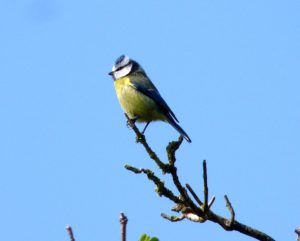 house:
house:
If you are still feeding birds, open your windows and try taking photos of birds on your feeders. You can even try through the glass. Even better if you can get a picture of a bird in a tree.
If you have a nest box or you know where a robin or blackbird, say, has made a nest, try keeping a record of 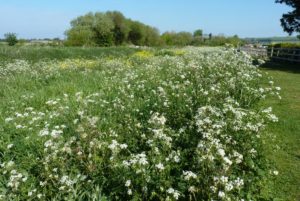 activities: taking in nesting materials, feeding young and fledglings. Keep a note of key dates and you can even record your findings on the website of the British Trust for Ornithology (BTO): www.bto.org.
activities: taking in nesting materials, feeding young and fledglings. Keep a note of key dates and you can even record your findings on the website of the British Trust for Ornithology (BTO): www.bto.org.
A walk up the Rife is a must in May. The white Cow Parsley is in full 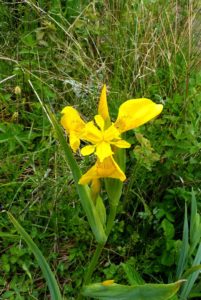 bloom all along the banks and the Yellow Flags (Yellow Iris) are just coming out. Soon, the Early Marsh Orchids will be in bloom.
bloom all along the banks and the Yellow Flags (Yellow Iris) are just coming out. Soon, the Early Marsh Orchids will be in bloom.
Two birds to look out for on the Rife which like the reeds. Reed Buntings sing from the tops of reeds or from bushes. Their song is a dull few notes but they are a lovely bird. Reed Warblers sing from lower down in the reeds and have an interesting chatty, jittery song which seems to go round in circles. They make their nests in the reeds whereas Reed Buntings usually nest in scrubby vegetation nearby.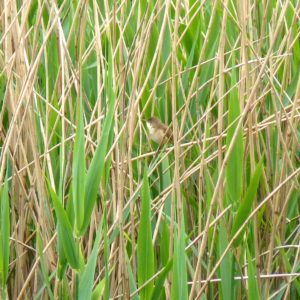
Local Wildlife Sightings – 20th April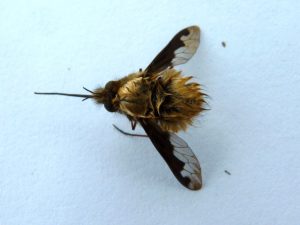
Butterflies: the early blues are Holly Blue and there are now Comma,
Peacock and Red Admiral, Green-veined Whites as well as Small White, Brimstones and lots of Orange Tips.
Look out for Bee Flies – they have a characteristic long pointed proboscis which is not only used for gathering nectar but also as an ovipositor into a host mining bee which it parasitises. Also keep an eye out for bright red Lilly Beetles.
If you want to help bees, why not 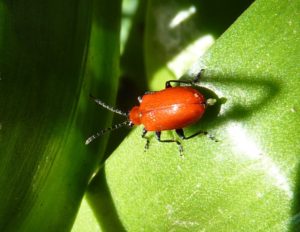 make a home-made Bee Hotel (see
make a home-made Bee Hotel (see
photo) and this is the perfect time to leave part of your lawn unmown to
make a mini-meadow.
There is a litter of 6 fox cubs nearby from a den under a shed is a nearby garden. The father helps feed the cubs while the mother keeps mainly in the den.
Clive Hall has reported a few 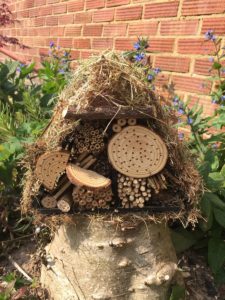 mornings of passage migration over the
mornings of passage migration over the
sea: Sandwich and Commic Terns, Common Scoter, Med. Gulls, Brent Geese,
Whimbrel, Arctic Skua, Kittiwake, Bar-tailed Godwit.
Common Whitethroat are back on the Rife but only a few Willow Warblers
heard. On Highdown,and especially up McIntyre’s Lane there are pairs of
Linnets, Common Whitethroat. Lesser Whitethroat, Blackcap, Chiffchaff
and lots of Skylarks.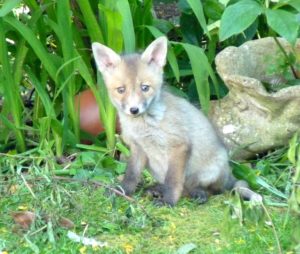
Woodland Spring Flowers – 13th April
If you are lucky enough to be near woodland or can walk along hedgerows, April is the perfect time to identify woodland flowers. Most flower early before they are shaded by the tree canopy above. The following is a list of 20 found in Patching Woods. See how many you can find, some may even be in your garden:-
Wood anemone (Anemone nemorosa) white/pink flowers
Primrose (Primula vulgaris) pale yellow flowers, large crinkly leaves
Bluebell (Endymion non-scriptus) blue, with cream anthers, long thin leaves
Dog’s Mercury (Mercurialis perennis) tiny, inconspicuous flowers
Violet (Viola species) blue/purple flowers, heart-shaped leaves
White Dead-nettle (Lamium album) white flowers, nettle-like leaves
Garlic Mustard (Alliaria petiolata) white flowers, other name Jack-by-the-Hedge
Ladies Smock (Cardamine pratensis) pale pink flowers, other name Cuckoo Flower
Greater Stitchwort (Stellaria holostea) white flowers, quite tall
Red Campion (Silene dioica) red flowers, tall
Lords-and-Ladies (Arum maculatum) purple or yellow spadix with green spathe (hood)
Wild Garlic (Allium ursinum) white flowers, strong-smelling, edible
Ground Ivy (Glechoma hederacea) violet/blue flowers, leaves kidney-shaped
Red Dead-nettle (Lamium purpureum) pink/purple flowers, square stems
Wood spurge (Euphorbia amygdaloides) tall, tiny flowers in yellow/green, cup-like bracts
Wood sorrel (Oxalis acetosella) white flowers, trefoil leaves, in ancient woods
Lesser Celandine (Ficaria verna) glossy yellow flowers, heart-shaped leaves
Goldilocks Buttercup (Ranunculus auricomus) small yellow variable petals, divided leaves
Early Purple Orchid (Orchis mascula) purple flowers in spike, black spots on leaves
Foxglove (Digitalis purpurea) very tall with purple flowers, large soft leaves
To help you identify the flowers, you can take photos on your phone or camera and then use the internet or an identification book to help you. I can recommend The Wild Flowers of Britain and Ireland by Blamey, Fitter and Fitter, second edition, 2013. Please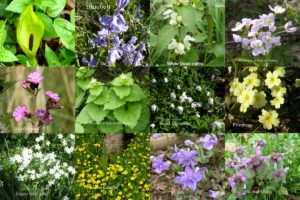 do not pick the flowers. If you make your own list in a note book, record when and where you find the flowers and then you will build up a useful plant list.
do not pick the flowers. If you make your own list in a note book, record when and where you find the flowers and then you will build up a useful plant list.
A collage of 12 of these woodland flowers may help your identification.
Butterfly Observations – 7th April
The warm weather is beginning to bring out the butterflies. Look out for the following in your garden or on your daily walk. These are common April butterflies: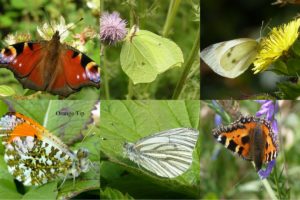
Peacock, often a pair doing a dance, spiraling into the air.
Small Tortoiseshell, often sunning itself on the ground.
Orange Tip, small, the female has grey rather than orange tips.
Small White, the first of the ‘cabbage whites’ to emerge.
Green-veined White, like Small White but underside has grey/green veins.
Brimstone, yellow, distinctive shape, female very pale yellow.
These 6 butterflies are shown on the collage to help you. See if you can tick off all 6 by the end of the month. Have you started your plant list yet? Now you can make a list of butterflies as well! Let me know if you record all six. There are other species as well which you may see. You could try and photograph them if they settle.
Look out for other insects in your garden. Have you seen a Bee Fly? They are very common this
The 10 Wild Flower Challenge – 3rd April
Being confined to Ferring, this is the perfect opportunity to get to know your local wild flowers. 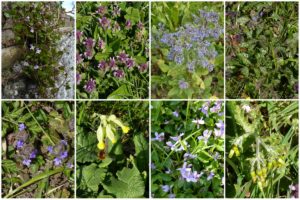 Your challenge is to go and identify the 10 flowers I have listed below. Many are what you may call weeds but some can look lovely in a wild place in your garden. I have suggested where you may find them:
Your challenge is to go and identify the 10 flowers I have listed below. Many are what you may call weeds but some can look lovely in a wild place in your garden. I have suggested where you may find them:
Ground Ivy, blue flowers, Little Paddocks
Lungwort, pink/purple flowers, Little Paddocks
Borage, blue flowers, lots on wild flower bed, Little Twitten
White Dead-nettle, white flowers, everywhere
Red Dead-nettle, in your garden?
Violets, blue, Highdown in chalk pit, Little Paddocks
Cowslips, yellow, in meadow below Highdown Gardens
Ivy-leaved Toadflax, purple, on walls
Shepherd’s Purse, tiny white flowers, in your garden?
Groundsel, tiny yellow flowers, in your garden?
My suggestion is that you make a list of these plants in a note book. See if you can find each one, then make columns for the date, where found and notes on identity. You can then build up your own plant list. Let me know if you do this!
The pictures are to help you but I have not named them!
This weekend it will get warmer and the winds are coming round to the south so look out for migrant birds arriving. There may be more butterflies too. Another list?
Observations and Suggestions 28th March
If you have a nest box or any nest in your garden, this might be a good time to keep a regular watch and record dates of bringing in nesting materials, food, and removal of faecal sacs and later fledgling. When baby birds are being fed it is amazing to see how frequently the adults come to the nest. You can count how many times in say 10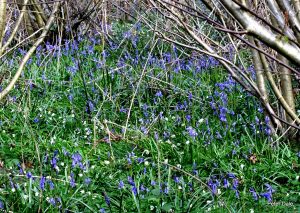 minutes. If you know where the nest boxes are around the village you could also record activity there.
minutes. If you know where the nest boxes are around the village you could also record activity there.
Keep an eye on the sky. There are many reports of buzzards (over the Rife, from David Bettiss) and kites and a pair of buzzard are probably breeding again on the west side of the East Preston/Ferring gap.
Bird song is brilliant at the moment. Check you can identify the song of robin and blackbird. You can see them singing to confirm identity. Try to learn one song at a time. Small migrants are starting to arrive: listen out for the first of the warblers, the chiffchaff. This is the easiest song to identify because all they do is go ‘chiff’ and ‘chaff’, like a pendulum. Don’t confuse with a great tit which goes ‘teach-er, teach-er”.
Graham has reported butterflies in his garden: a comma, peacock and brimstone Brimstones are pale yellow, males brighter than females. I have seen small tortoiseshell and red admiral. Any records of small tortoiseshell would be useful.
Graham Tuppen has evidence of hedgehogs in his garden and he says that bluebells are just beginning to come out in Clapham Woods together with the lovely wood anemones.
Being somewhat confined, might be a good time to start doing some daily records of observations in your garden. You might be surprised at what turns up! A note book and identification books are all you need whilst sitting in the sun.
January Bird Sightings
On the 21/01/2020, on a lovely sunny morning, Clive and I took a walk up the Rife and on to the East Preston/Ferring Gap. Highlight was a Water Rail just north of the road bridge. On the gap were at least 8 Skylark and 12 plus Pied Wagtail’ There were a few small groups of Greenfinch and 2 Stock Dove at east Kingston. No Kingfisher or Grey Wagtail but these were seen on Christmas Day. Two Herons, 3 Little Egret, Kestrel and Buzzard have been fairly regular in the Rife area.
The following birds were singing: Robin, Song Thrush(3), Dunnock, Great Tit, Skylark and, surprisingly, Chaffinch. Both woodpeckers were heard.
Bird Sightings
There was a good passage of Swallows, House Martins and Meadow Pipits totaling well over a thousand birds moving west along the coast and over the fields at Goring Gap on Monday September 30th on what was one of the calmer mornings of the period. A group of four Wheatears appeared later on the beach there, two of them showing features of the larger ‘Greenland’ race.
Wasp Spider
Whilst counting butterflies in the lagoons west of the Rife, a Wasp Spider was spotted. This uncommon, introduced species mimics wasps with its black and yellow striped abdomen thus avoiding predators. It builds an orb web with a decoration called the stabilimentum in the centre which may attract its prey. The female is large, 15mm, but the male is an insignificant brown and only 4.5mm. It tries to creep in and mate with the female without being eaten. He waits until her final moult and rushes in while her jaws, or chelicerae, are still soft so hopefully avoiding cannibalism. Some males actually stop further males from mating by ‘plugging’ the female with their own body! There’s dedication for you!
Found in southern England, Europe, North Africa and Asia and even some eastern USA states, the Wasp Spider appears to be extending its range.
Making your garden Hedgehog friendly
Avoid using slug pellets.
Make it easy for them to come in by making holes in/gaps under fences. If you have hedges, avoid having chicken wire barriers in them. They need holes of approx 15cm/6in diameter. They can climb, but are unlikely to scale a 6 foot fence.
Have water available in your garden for them (and all other wildlife) to drink. If you have a pond, give them an escape ramp of some sort, they can swim but are not able to do so indefinitely.
If you want to feed them, don’t leave bread and milk for them, as this is actually bad for their tummies. Dog or cat food is better, left out overnight. Apparently they like chicken flavour, but avoid all fish. They will eat unsalted peanuts and apparently some cheese. The risk of dog/cat food is that you will simply be feeding foxes (and possibly dogs and cats). It is possible to buy dried foods (eg Spike’s and Ark wildlife) specifically for hedgehogs which should avoid this problem (eg Shoreline pets in the Mulberry parade, Goring stock some).
For hibernating, a loose woodpile is ideal, but you can either buy hedgehog houses, or make one. The basic requirement is a dry chamber, with an entrance tunnel approx 13cm dia, long enough to prevent a fox from reaching into the chamber. Ideally the tunnel should slope down slightly from the chamber, to prevent water running in. The chamber should be covered with a waterproof material, and preferably then covered in earth or vegetation, and a supply of suitable bedding material such as straw and leaves nearby is useful. The home should be in a quiet, cool, shady spot, with the entrance facing away from cold winds (not North or Northeast). An old plastic milk crate with the internal partitions removed is suitable. If making one of wood, avoid material which is treated with preservatives, other than water-based. Approx 30 x 30 x 40cm/15 x 15 x 19 in. internal size. Avoid disturbing it if there is a resident!, one way to check in the Spring is to put a light obstruction over the entrance and see if it is pushed out of the way overnight. In the summer it is a good idea to clean it out, an organic pyrethrum powder suitable for caged birds is ok.
For further information, do have a look at an excellent website – www.hedgehogstreet.org
Information provided by Graham Tuppen (5.7.2017)
Winter Storms
Recent storms have pushed the shingle into a steep bank high up on our beach. At low tide it appears that even more sand has disappeared.
This is a good time, however, for a beach comb. A lobster was found today together with a good variety of seaweeds and also shells and egg cases. Take a stroll along the tide line and report any interesting finds.
Tricia 01/12/2015

